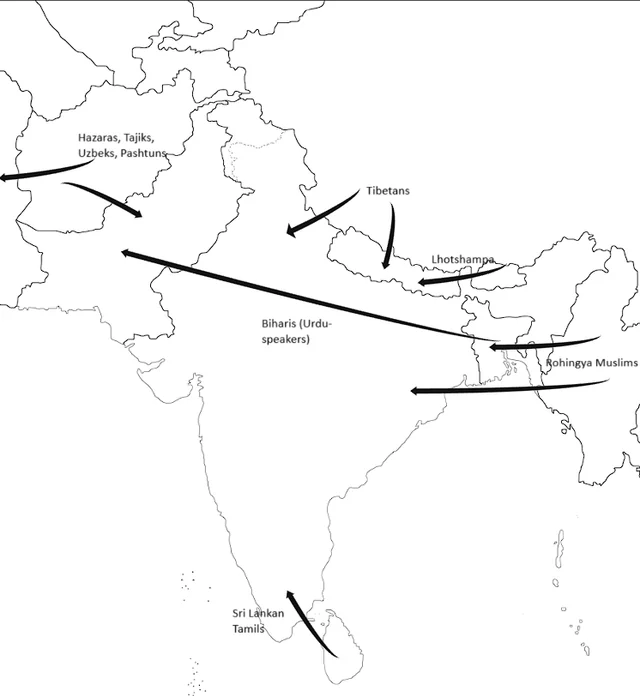Ethnic Exodus Map of South Asia Post-1970


David Chen
Data Visualization Specialist
David Chen is an expert in transforming complex geographic datasets into compelling visual narratives. He combines his background in computer science ...
Geographic Analysis
What This Map Shows
This map titled "South Asia’s Ethnic Exodus: Tracking Persecution-Triggered Migrations After 1970" visually represents the significant migrations that have occurred in South Asia in response to ethnic persecution since 1970. It highlights key routes and destinations of displaced populations, illustrating how political unrest, religious discrimination, and ethnic conflicts have driven people from their homelands. The map serves as a poignant reminder of the human cost of such conflicts, showcasing not only the affected regions but also the diverse ethnic groups involved in these migrations.
Deep Dive into Ethnic Persecution and Migration
The phenomenon of ethnic persecution leading to migration is complex and deeply rooted in historical, cultural, and socio-political factors. In South Asia, various groups have faced systemic discrimination, violence, and even genocide, prompting mass migrations. For instance, the 1971 Bangladesh Liberation War resulted in millions of Bengalis fleeing to India due to brutal military oppression. Similarly, the ethnic cleansing of Tamils in Sri Lanka during the civil war drove a significant number of Tamils to seek refuge in foreign lands.
Interestingly, the map illustrates not only the outflow of people but also the demographic shifts within South Asia itself. For example, the exodus of Rohingya Muslims from Myanmar to Bangladesh is a stark reminder of the ongoing ethnic conflicts in the region. The Rohingya have faced severe persecution characterized by violence, discrimination, and denial of citizenship, pushing them into overcrowded refugee camps in Cox's Bazar, one of the largest refugee settlements in the world.
Moreover, the plight of the Ahmadiyya community in Pakistan highlights another dimension of this issue. Have you noticed how religious minorities often bear the brunt of intolerance? Since the late 20th century, Ahmadiyyas have faced increasing persecution, leading many to migrate to countries where they can practice their faith freely. These migrations are not merely geographical shifts; they represent a search for safety, dignity, and a chance to rebuild lives in more tolerant societies.
The implications of these migrations are far-reaching, affecting both the countries of origin and the host nations. Economically, the loss of a skilled workforce can hinder development in the home country, while receiving countries must grapple with the challenges of integration, including social cohesion and resource allocation.
Regional Analysis
In South Asia, the patterns of migration can be distinctly observed across various regions. For instance, Northern India has been a significant destination for refugees fleeing from Pakistan and Bangladesh. Cities like Delhi and Kolkata have seen a marked increase in their populations due to the influx of migrants escaping persecution.
Conversely, in Sri Lanka, the Tamil diaspora is widespread, with many seeking asylum in countries like Canada and the UK. The map clearly delineates these trends, showing how specific ethnic groups gravitate towards particular areas, often based on existing community ties or the availability of support networks.
Interestingly, the migration of ethnic minorities from Afghanistan, such as the Hazara people, has added a different layer to the regional dynamics. Many have journeyed to Western nations in search of asylum from Taliban rule. This highlights the interconnectedness of ethnic conflicts across South Asia, with the map illustrating these complexities through migration patterns.
Significance and Impact
Understanding the ethnic exodus in South Asia is crucial for several reasons. Firstly, it sheds light on the broader implications of ethnic conflicts and the urgent need for humanitarian intervention. The map serves as a visual representation of the human rights violations that compel people to leave their homes and seek refuge elsewhere.
Moreover, current trends indicate that these migration patterns may continue to evolve, especially in the face of climate change, which disproportionately affects marginalized communities. As environmental factors increasingly intersect with ethnic tensions, the potential for further displacement grows. This calls for a comprehensive approach to address not only the immediate needs of refugees but also the root causes of their plight.
In conclusion, this map is more than just a visualization of movements; it tells the stories of individuals and communities affected by persecution in South Asia. By recognizing these narratives, we can better understand the complexities of migration and the importance of fostering inclusive societies that respect and protect the rights of all ethnic groups.
Visualization Details
- Published
- August 17, 2025
- Views
- 106
Comments
Loading comments...